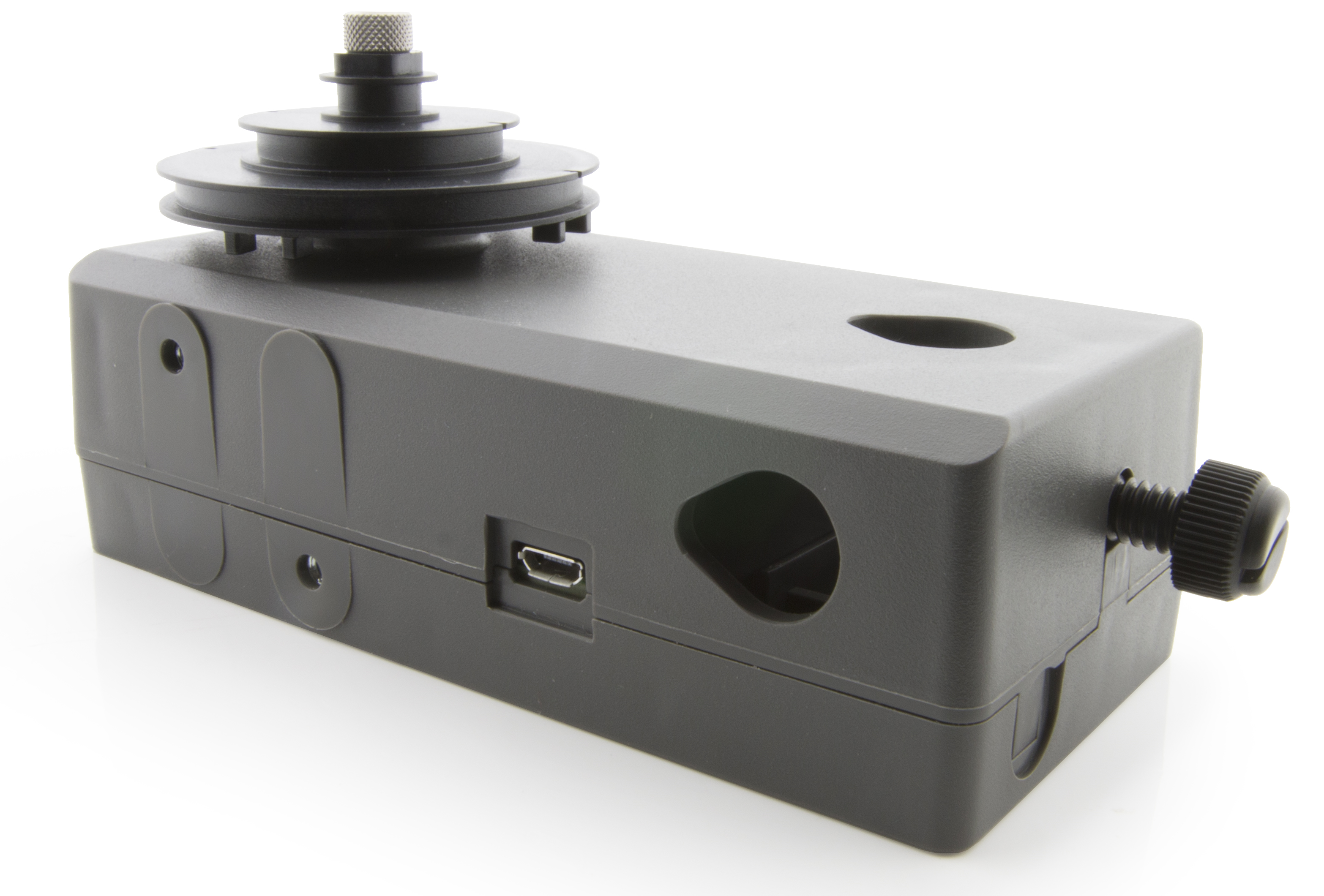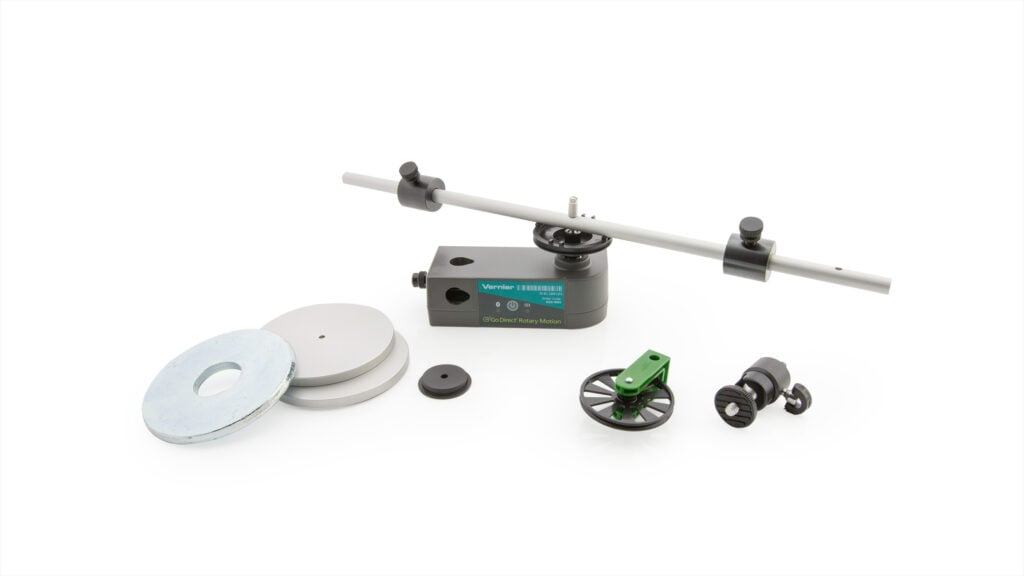Go Direct® Rotary Motion Sensor User Manual
Order Code: GDX-RMS
Go Direct Rotary Motion is a bidirectional angle sensor designed to measure rotational or linear position, velocity and acceleration. It is used for a variety of applications, including
- Determining rotational inertia
- Investigating angular motion applications of Newton's second law
- Investigating conservation of angular momentum
- Investigating the effect of light intensity when passed through polarizing filters (Malus's law)
- Studying the motion a physical pendulum
- Measuring linear position
Note: Vernier products are designed for educational use. Our products are not designed nor are they recommended for any industrial, medical, or commercial process such as life support, patient diagnosis, control of a manufacturing process, or industrial testing of any kind.
What's Included
- Go Direct Rotary Motion
- Micro USB Cable
- Thumb screw
- 3-step pulley and mounting screw
- O-ring
Compatible Software
Choose a platform below to see its compatibility requirements.LabQuest
Interface LabQuest App LabQuest 3 Full support LabQuest 2 Full support 1 LabQuest Incompatible Compatibility Notes
Computers
Software Interface Graphical Analysis Graphical Analysis (Web App) No interface required Full support Full support LabQuest 3 Full support 1 Incompatible LabQuest 2 Full support 1 2 Incompatible Compatibility Notes
Chromebook
Software Interface Graphical Analysis (Web App) No interface required Full support iOS
Software Interface Graphical Analysis Graphical Analysis GW No interface required Full support Full support LabQuest 3 Full support 1 2 Full support 1 2 LabQuest 2 Full support 1 2 3 Full support 1 2 3 Compatibility Notes
Android
Software Interface Graphical Analysis Graphical Analysis GW No interface required Full support Incompatible LabQuest 3 Full support 1 2 Full support 1 LabQuest 2 Full support 1 2 3 Full support 1 3 Compatibility Notes
Python
Software Interface Python No interface required Full support Javascript
Software Interface Javascript No interface required Full support 1 Compatibility Notes
LabVIEW
Software Interface NI LabVIEW No interface required Full support
Assembly
The 3-step pulley can be mounted on the rotating shaft in either of two orientations: with the wide side of the pulley near the sensor body, or with the narrow side of the pulley near the sensor body. The easiest way to insert the 3‑step pulley on the Rotary Motion Sensor shaft is hold the shaft to prevent rotation as you turn the pulley to align the key to the slot. The O-ring can be slipped over the outer pulley to increase friction when the pulley is in contact with a surface.
The thumb screw can be threaded into the back of the sensor allowing the Rotary Motion Sensor to be attached to a ring stand.
The sensor also has a set of accessory mounting holes that allow it to connect to existing accessories such as the Polarizer Analyzer (PAK-OEK) and the Rotary Motion Motor Kit (MK-RMV).

Quick Start: Vernier Graphical Analysis® and Bluetooth®
- Charge your sensor for at least 2 hours before first use.
- Turn on your sensor. The LED will blink red.
- Launch Graphical Analysis, then click Sensor Data Collection.
- Select your sensor from the list. The sensor ID is located on the sensor label near the bar code. Note: If you don’t see a list of available sensors, click WIRELESS. After selecting your sensor, click Pair.
- This is a multi-channel sensor. Click SENSOR CHANNELS and select the channel(s) you want to use.
- Click DONE. You are now ready to collect data.
Using other Vernier data-collection apps or want to connect via USB?
Visit www.vernier.com/start-go-direct
Note: This sensor also works with LabQuest 2 and LabQuest 3; it does not work with the original LabQuest.
Charging the Sensor
Connect the Go Direct Rotary Motion to the included USB Charging Cable and any USB device for two hours.
You can also charge up to eight Go Direct Rotary Motion Sensors using our Go Direct Charge Station, sold separately (order code: GDX-CRG). An LED on each Go Direct Rotary Motion indicates charging status.
| Charging |
Orange LED next to the battery icon is solid while the sensor is charging. |
| Fully charged |
Green LED next to the battery icon is solid when the sensor is fully charged. |
Powering the Sensor
| Turning on the sensor |
Press button once. Red LED indicator next to the Bluetooth icon flashes when the unit is on. |
| Putting the sensor in sleep mode |
Press and hold button for more than three seconds to put into sleep mode. Red LED indicator next to Bluetooth icon stops flashing when sleeping. |
Connecting the Sensor
See the following link for up-to-date connection information:
Connecting via Bluetooth
| Ready to connect | Red LED next to the Bluetooth icon flashes when sensor is awake and ready to connect. |
| Connected | Green LED next to the Bluetooth icon flashes when sensor is connected via Bluetooth. |
Connecting via USB
| Connected and charging | Orange LED next to the battery icon is solid when the sensor is connected to Graphical Analysis via USB and the unit is charging. LED next to Bluetooth icon is off. |
| Connected, fully charged | Green LED next to the battery icon is solid when the sensor is connected to Graphical Analysis via USB and fully charged. LED next to Bluetooth icon is off. |
| Charging via USB, connected via Bluetooth |
Orange LED next to the battery icon is solid when the sensor is charging. Green LED next to the Bluetooth icon flashes. |
Identifying the Sensor
When two or more sensors are connected, the sensors can be identified by tapping or clicking Identify in Sensor Information.
Using the Product
Connect the sensor following the steps in the Quick Start section of the user manual.
Channels
Go Direct Rotary Motion has two channels:
- Angle
- Angle (High Resolution)
Angle
Angle is a default channel that is active when the sensor is connected. Angle provides precision to 1° of rotation.
Angle (High Resolution)
Angle (High Resolution) can be selected to take advantage of the quadrature encoder. This increases the precision to 0.25° of rotation.
Specifications
|
Resolution |
1° or 0.25° Note: High resolution mode is also known as ×4 mode. When active, the sensor has a 0.25 degree resolution and a limited maximum measurable rotational velocity. |
|
Accuracy |
≤ ±1.0% FS |
|
Optical encoder |
Bidirectional, quadrature encoder, 360 cycle per revolution |
|
Maximum speed |
30 rev/s at 1° resolution 7.5 rev/s at 0.25° resolution |
|
3-step pulley |
10 mm, 29 mm, and 48 mm groove diameter, 55 mm with O ring in groove |
|
Battery |
300 mA Li-Poly |
|
Battery life
|
~24 hours |
|
Battery life (long term) |
~500 full charge cycles (several years depending on usage) |
Care and Maintenance
Battery Information
The Go Direct Rotary Motion contains a small lithium-ion battery. The system is designed to consume very little power and not put heavy demands on the battery. Although the battery is warranted for one year, the expected battery life should be several years. Replacement batteries are available from Vernier (order code: GDX-BAT-300).
Storage and Maintenance
To store the Go Direct Rotary Motion for extended periods of time, put the device in sleep mode by holding the button down for at least three seconds. The red LED will stop flashing to show that the unit is in sleep mode. Over several months, the battery will discharge but will not be damaged. After such storage, charge the device for a few hours, and the unit will be ready to go.
Exposing the battery to temperatures over 35°C (95°F) will reduce its lifespan. If possible, store the device in an area that is not exposed to temperature extremes.
Water Resistance
The Go Direct Rotary Motion is not water resistant and should never be immersed in water.
If water gets into the device, immediately power the unit down (press and hold the power button for more than three seconds). Disconnect the sensor and charging cable, and remove the battery. Allow the device to dry thoroughly before attempting to use the device again. Do not attempt to dry using an external heat source.
How the Sensor Works
The Go Direct Rotary Motion uses a quadrature optical (incremental type) encoder to measure the amount and direction of rotation. The encoder, which is attached to the rotating sensor shaft, consists of a coded pattern of opaque and transparent sectors. The quadrature encoder produces two pulse output patterns 90° apart in phase. The position of the shaft is determined by counting the pulses. The phase relationship between the output signals determines the direction of rotation.
Troubleshooting
For troubleshooting and FAQs, see www.vernier.com/til/4051
Repair Information
If you have followed the troubleshooting steps and are still having trouble with your Go Direct Rotary Motion, contact Vernier Technical Support at support@vernier.com or call 888-837-6437. Support specialists will work with you to determine if the unit needs to be sent in for repair. At that time, a Return Merchandise Authorization (RMA) number will be issued and instructions will be communicated on how to return the unit for repair.
Accessories/Replacements
| Item | Order Code |
|---|---|
|
AK-RMV |
|
|
MK-RMV |
|
|
CB-USB-MICRO |
|
|
CB-USB-C-MICRO |
|
|
GDX-BAT-300 |
Warranty
Warranty information for this product can be found on the Support tab at www.vernier.com/gdx-rms/#support
General warranty information can be found at www.vernier.com/warranty
Disposal
When disposing of this electronic product, do not treat it as household waste. Its disposal is subject to regulations that vary by country and region. This item should be given to an applicable collection point for the recycling of electrical and electronic equipment. By ensuring that this product is disposed of correctly, you help prevent potential negative consequences on human health or on the environment. The recycling of materials will help to conserve natural resources. For more detailed information about recycling this product, contact your local city office or your disposal service.
Battery recycling information is available at www.call2recycle.org
Do not puncture or expose the battery to excessive heat or flame.
 The symbol, shown here, indicates that this product must not be disposed of in a standard waste container.
The symbol, shown here, indicates that this product must not be disposed of in a standard waste container.
Contact Support
Fill out our online support form or call us toll-free at 1-888-837-6437.

